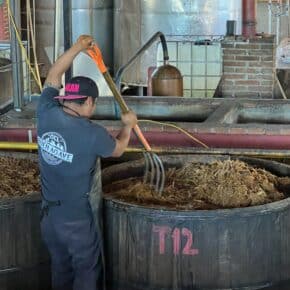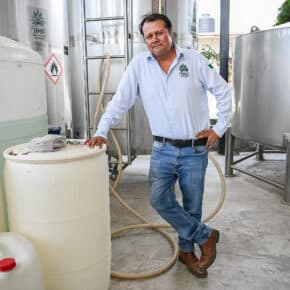The agave news story trend in April was all about the crashing of agave prices. It was interesting to see the coverage, with most of it presented in a manner of the sky is falling alongside predictions that it was a sign that the agave spirits boom was over. The fact is, this is something everyone in the industry saw coming beginning last spring. When I was in Jalisco last June folks were already talking about the over abundance of agave and the falling price but no one was surprised as this is a cyclical occurrence – the demand for agave spirits increases so people jump in to plant more agave.
Demand during the pandemic went through the roof for agave spirits and created a mentality of 30%+ year over year growth for perpetuity. Obviously, this is not realistic and we now are seeing a glut of agave as what was planted in 2019 and 2020 is now coming into the market. While we think of agave taking 7 years to mature, immature agaves are used in diffusers and with the use of fertilizers etc, agaves can mature faster than in previous times. Prices in Jalisco have fallen to about 10-11 pesos per kilo for Tequilana Weber from 30 at its high, in Oaxaca it is now about 2.5-3 pesos per kilo for Espadin down from its high of around 11.
What does this mean?
Will the price of agave spirits plummet? No, supply chain, inflation and exchange rates will keep pricing, particularly with non-tequila agave spirits, the same.
Will a bunch of new brands try to enter the market at lower prices because the tequila or mezcal is being made with agave at the lower price point? Maybe, but those brands will have to put more money into marketing to compete in a fairly saturated market and would eventually have to raise prices. Tequila could definitely become more price competitive, especially among the lower end brands entering the market.
Will people stop planting agave? Probably, which is exactly why this is so cyclical – in a few years there will be an agave “shortage” which will push the price up which will drive people to plant a bunch of agave which will then cause prices to drop again. We have seen this happen at least three times in the past 20 or so years.
But there are a few things that are a little different with this cycle. Now that Jalisco has been granted entry into the world of avocado exports, land that previously might have been planted with agave could now be planted with avocado (or mango) trees given the profitability there, putting more pressure on water use in a region seeing hotter and drier weather patterns. This would lessen the amount of agave that would be available in the future. There is also a labor shortage issue in Jalisco, with many trained jimadores retiring and younger people choosing other career paths, making it harder to find people to harvest the agave.
Why do agave prices in Jalisco impact Oaxaca?
As agave prices increase in Jalisco, people look south to purchase cheaper agave from Oaxaca to be used in agave syrup and inulin production, and if you believe the “rumors”, in tequila production. This leads to increased agave cultivation in Oaxaca because there is greater demand, but now that the price is so low, those trucks full of Espadin heading north are fewer and farther between, creating a similar boom and bust agave cycle now in Oaxaca as in Jalisco. Ironically, the best time to plant agave is when the price is so low because everyone knows there will eventually be a shortage because of this endless cycle. There are lessons to be learned from Jalisco for so many things, the agave cycle being just one, though it appears if they are being learned, it is happening slowly.
In Oaxaca, as in Tequila, bulk of the agave spirits market is controlled by large producers/brands and they are somewhat insulated from agave price fluctuations. Most control their supply chain of agave and grow the majority of their own agave used in production. In the case of mezcal, for smaller producers, while many also grow their own, they also sell agave because at the end of the day, most producers are in fact agave farmers. The price drop for them is more consequential as it cuts into their cash flow and makes it harder to reinvest, either in agave plants or their distilleries/palenques.
So what can be done?
Plant wild agave. As agaves like the Tequilana and Espadin have become more like commodity products, and therefore more exposed to market fluctuations, it makes sense to plant wild agaves. Not only is it a way to preserve varieties, they are also less prone to the price fluctuations that Tequilana and Espadin endure.
The devil is in the details when it comes to planning and coming up with a balance of wild agave planting and Espadin cultivation. Now would be a great time to let even more Espadin go to seed and plant from those. And encouraging greater coordination among producers and municipalities, especially when it comes to how and where to grow the various varieties could be a good idea. Regionality with native varieties needs to be considered, which is to say, plant what is native to your area. What cannot get lost in this conversation is how agaves are planted.
Government can play a role. If agaves like Tequilana and Espadin are considered more like commodities, should a system of price controls be established to protect farmers from the fluctuations? This is certainly worth a discussion along with a whole lot of economic modeling because price controls are complicated and have a mixed record.
Consumers need to be more invested in their decision making and support brands which are focused on sustainability and smart growth because ultimately, the diversity of the world of mezcal, not only regarding agaves but also flavors and traditions, because that will help determine the future of mezcal.
What is pretty clear is that 2024 remains on track to be a bumpy ride for agave spirits as the market continues to adjust to the post pandemic world.













Leave a Comment